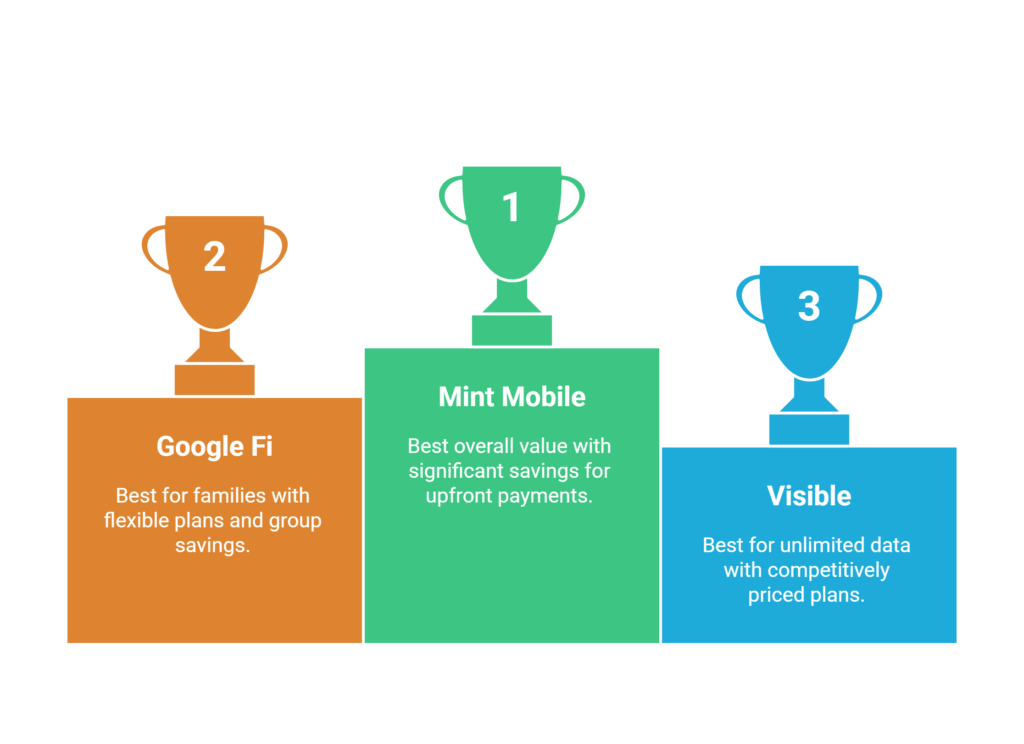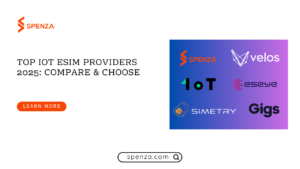Table of Contents
- Introduction: Why Consider an MVNO in 2025?
- What Exactly is an MVNO?
- How Do MVNOs Operate?
- Understanding MVNO Types
- The Core Enabler: Understanding MVNO APIs
- MVNO vs. Major Carrier: Key Differences
- Best MVNO Carriers for 2025
- How to Choose the Best MVNO Option for You
- Conclusion: Making the Right Choice in 2025
- FAQs
Introduction
Your smartphone is your lifeline, but keeping it connected shouldn’t break the bank. If you’re paying too much for cellular service, a Mobile Virtual Network Operator (MVNO) might be the perfect solution. MVNOs offer many benefits of traditional carriers at a fraction of the cost because they lease access to the same networks used by the Big Three—AT&T, Verizon, and T-Mobile—while delivering unique, flexible, and budget-friendly plans.
In today’s ever-evolving mobile landscape, major carriers often dominate headlines with their expansive 5G rollouts and high-profile marketing. Yet, more and more users are discovering that MVNOs provide incredible value and versatility without sacrificing coverage or performance. The global MVNO market was valued at $79.2 billion in 2023 and is expected to grow at a compound annual growth rate (CAGR) of 8.8% from 2024 to 2030, reaching an estimated $141.9 billion by 2030.
This guide will help you understand what an MVNO is, explore the potential benefits and various types available, and even explain how businesses can tap into MVNO APIs to launch their branded mobile services. Whether you’re an individual looking to lower your monthly bill or a business seeking to customize your mobile offerings, read on to discover the top consumer MVNO options for 2025.
What Exactly is an MVNO?
An MVNO (Mobile Virtual Network Operator) is a wireless communications service provider that doesn’t own the wireless network infrastructure it uses. Instead, MVNOs enter into business agreements with traditional Mobile Network Operators (MNOs – think Verizon, T-Mobile, AT&T) to purchase network access (like data, voice, and text services) at wholesale rates.
How they differ from Major Carriers (MNOs):
- Infrastructure: MNOs build and maintain their own cellular towers and network infrastructure. MVNOs lease access to these networks.
- Focus: MNOs often balance network management with retail services. MVNOs typically focus primarily on the retail and customer service aspects, sometimes targeting specific niches.
How Do MVNOs Operate?
It’s simple: MVNOs lease network capacity (the “pipes”) from one or more major MNOs. When you make a call, send a text, or use data on an MVNO plan, you’re using the physical towers and infrastructure of the underlying MNO partner (like AT&T, T-Mobile, or Verizon). This means MVNOs can offer coverage that’s just as good as the major carrier they partner with.
Know More About MVNO:
- Designing an Impactful User Experience and Customer Support in MVNOs
- How to launch a MVNO with SPENZA
- Introduction to MVNOs in the US: Market Dynamics, Challenges, and Successes
Understanding MVNO Types
Not all MVNOs operate the same way. MVNO types range from simple resellers to operators with significant independent infrastructure.

- Branded Resellers / Light MVNOs: These simply re-brand and resell the MNO’s services, relying heavily on the MNO for most operations. They often compete on price and simplicity.
- Full MVNOs: These operators have more independence. They manage their billing systems, customer service, and marketing, essentially controlling the entire customer relationship while still leasing the radio network access.
- Skinny MVNOs: They do not own network equipment or infrastructure but provide services through specialized customer support, marketing, and sales operations.
- Thick MVNOs: These are more self-sufficient service providers, such as GMSC for voice services, GGSN for data services, and HSS/HLR for subscribers. They also put in place their billing system.
- Niche MVNOs: These target specific customer segments, like budget-conscious users, families, international travellers, or seniors, offering plans tailored to those needs.
- Integrated MVNOs / MVNEs (Enablers): These provide platforms and services for other businesses to become MVNOs. They handle the complexities of dealing with MNOs, offer management tools, and often provide APIs for seamless integration. Spenza fits into this category as a connectivity enablement platform.
The Core Enabler: Understanding MVNO APIs
For businesses looking to offer their own branded mobile plans – perhaps bundled with devices or as a value-add for customers – MVNO APIs are transformative.
What is an MVNO API?
An MVNO API is a specialized Application Programming Interface that enables a business’s digital systems—such as its website, mobile app, or operational software—to directly interact with its connectivity platform. In essence, it lets you manage your entire mobile service operation programmatically.
An MVNO API gives you comprehensive control over your operations. It lets you build and manage multiple business models, craft custom tariffs and services, and even develop applets for both SIM cards and MVNO subscribers. Despite not owning a radio network, the API allows you to operate as if you were a Host Network Operator (HNO) by providing robust tools for SIM management, DID allocation, and traffic utilization.
Why an API-First Approach Matters
- Speed to Market: Launch branded mobile services in hours or days, not months.
- Flexibility: Embed connectivity directly into your existing customer experiences and operational workflows.
- Automation: Automate tasks like SIM activation, plan changes, usage monitoring, and billing.
- Customization: Build unique mobile offerings tailored precisely to your customers’ needs.
Spenza’s API Capabilities
- Procure mobile plans from a marketplace of operators.
- Activate and manage SIMs/eSIMs.
- Monitor data usage in real-time.
- Intelligently adjust plans based on usage.
- Integrate with billing and operational systems.
- Deploy white-label apps for end-users.
Essentially, Spenza acts as the “Stripe for connectivity,” simplifying the process for B2B and B2C companies to become MVNOs and generate new revenue streams.
MVNO vs. Major Carrier(MNO): Key Differences
| Feature | Major Carrier (MNO) | Mobile Virtual Network Operator (MVNO) |
|---|---|---|
| Network | Owns & operates infrastructure | Leases infrastructure from MNO(s) |
| Cost | Often higher due to overheads | Generally lower, more budget-friendly |
| Plans | Can be complex, often contract-based | Often simpler, flexible, prepaid focus |
| Perks | May include streaming subs, hotspots, etc. | Fewer bundled perks, focus on core service |
| Phone Selection | Wide range, financing options | Often BYOD focused, fewer financing deals |
| Customer Service | Large call centers, retail stores | Variable; some highly rated, often online-focused |
| Data Priority | Highest priority on their network | May be deprioritized during congestion |
Best MVNO Carriers for 2025 (Consumer Focus)
If you’re looking for a personal plan, here are some top contenders in various categories for 2025 (based on recent reviews and market analysis):

- Best Overall Value: Mint Mobile (uses T-Mobile network) often leads here, offering significant savings when you pay for multiple months upfront.
- Best for Unlimited Data: Visible (uses Verizon network) provides competitively priced unlimited plans, often with taxes and fees included. Google Fi is also a strong contender.
- Best for Families: Google Fi (uses T-Mobile & US Cellular) offers flexible plans and good group savings. Some international options like Tesco Mobile (UK) are also noted for family perks.
- Best Budget-Friendly / Low Usage: Mint Mobile’s lower-data tiers are very affordable. Other carriers like Tello (uses T-Mobile) are also popular choices for light users.
- Best for Coverage: Coverage depends entirely on the MNO partner. Visible uses Verizon’s extensive network. Mint Mobile and Google Fi leverage T-Mobile’s strong 5G network. Consumer Cellular (uses AT&T and T-Mobile) is also popular, especially among seniors. Always check coverage maps for your specific area.
- Best for Travelers: Google Fi is often highlighted for its seamless international roaming features included in some plans.
Disclaimer: Plan details, pricing, and rankings can change. Always check the provider’s website for the most current information and verify coverage in your specific location before switching.
Top MVNO Carriers in 2025
As mobile virtual network operators (MVNOs) continue to reshape the wireless landscape, several carriers are emerging as frontrunners in offering competitive, flexible plans without sacrificing performance. Here’s an updated look at the best MVNO carriers of 2025, highlighting what sets each apart.
1. Google Fi
Google Fi distinguishes itself by dynamically selecting the strongest connection available from Sprint, T-Mobile, or US Cellular. Designed for users with compatible devices—such as the Google Pixel 9 or Samsung Galaxy S26 series—Google Fi provides excellent 5G service. Although most unlocked phones will only access T-Mobile’s network (and its 5G features), phones labeled as “Designed for Fi” can leverage the full network. For peace of mind, potential subscribers can verify their device compatibility using Fi’s online checker.
2. Cricket Wireless
Cricket Wireless has become even more attractive recently by eliminating data speed limitations on its contracts. With its removal of throttling on lower-tier plans, Cricket’s competitively priced packages now rival those of other carriers, making it a strong choice for budget-conscious users seeking robust performance.
3. US Mobile
US Mobile offers a customizable range of plans—from limited minutes to unlimited talk, text, and data. It’s a smart choice for backup or emergency phones, as well as for users who want to tailor their plan to fit their specific needs. The carrier’s unlimited plans provide excellent value: the Absolute Basic plan starts at $35 per month for a single line, with discounts as you add lines, and includes 30GB of premium data along with 5G access (including C-band). For users requiring more data, the Unlimited Premium plan ups the ante with 100GB of premium data and an additional 50GB of hotspot usage.
4. Consumer Cellular
Well-known for its customer-centric approach, Consumer Cellular caters particularly well to seniors. With a wide range of plan options and special discounts for AARP members (an extra 5% off), it offers low-cost solutions without compromising on service quality.
5. Ting Mobile
Ting Mobile is celebrated for its affordability and flexibility. Its plans start as low as $10 per month for unlimited calling and texting, with data priced at $5 per gigabyte. The Ting Flex plan, comparable to Google Fi’s flexible offerings, is especially attractive for users with modest data needs. For heavier users, Ting’s unlimited options—with data caps at 22GB or 35GB—ensure that you only pay for what you truly use. Additionally, all plans include hotspot capabilities, making it easy to share your connection on the go.
6. Xfinity Mobile
Xfinity Mobile stands out as a full-service MVNO that leverages Verizon’s robust network. Exclusively available to Comcast internet subscribers, it offers competitive unlimited plans with additional savings when you add more lines, making it a smart option for families and households looking to bundle services.
7. Visible
Visible by Verizon simplifies the experience with just two straightforward unlimited plans. Its base plan provides full access to Verizon’s LTE and 5G networks—with the caveat of lower data prioritization during peak times. For those who need more consistency, Visible+ offers an upgrade with 50GB of premium data and even faster speeds on Verizon’s Ultra Wideband 5G (using C-band or mmWave). This plan also includes international roaming and calling features, catering to users with global connectivity needs.
8. Mint Mobile
Mint Mobile continues to shine among MVNOs operating on T-Mobile’s network. With an array of prepaid plans ranging from 4GB to unlimited data, Mint Mobile offers exceptional overall pricing along with a selection of budget-friendly handsets, making it an excellent option for cost-conscious consumers.
9. Tello
Tello offers a no-nonsense prepaid service that lets you customize your plan by selecting the exact number of minutes and data you need—all while enjoying unlimited texting. For light users, a 500MB plan paired with unlimited calling is a budget-friendly option. More data-intensive users can opt for a 10GB package or even an unlimited plan that caps at 25GB before throttling. Importantly, even when data is exhausted, Tello slows speeds rather than imposing overage fees, ensuring that basic connectivity remains intact for messaging and email.
The 10GB plan is a fantastic place to start for heavy users, with enough data for light streaming, social media browsing, and texting. If you want additional data, the unlimited plan allows you up to 25GB, which should be more than adequate for most users. Even if you use it all, you will not be disconnected, only slowed down. When you’ve used up all of the data on your Tello plan, you’re not charged an overage fee, and your data is merely delayed. While it is not fast enough for YouTube, it is sufficient for messaging and email.
How to Choose the Best MVNO Option for You
Whether for personal use or evaluating options before engaging an enabler like Spenza, consider these factors:
- Coverage: This is crucial. Check the coverage map of the underlying MNO (Verizon, T-Mobile, or AT&T) in areas you frequent.
- Data Needs: Estimate your typical monthly data usage. Don’t pay for unlimited if you only use a few GBs.
- Budget: Determine how much you’re willing to spend per month. MVNOs offer plans at nearly every price point.
- Phone Compatibility: If bringing your own device (BYOD), ensure it’s compatible with the MVNO’s network. Most MVNOs have an online checker.
- Features & Perks: Do you need mobile hotspot data, international calling/roaming, or specific family plan features? Compare what’s included.
- Customer Service: Read reviews to gauge the typical customer service experience (e.g., online chat, phone support).
Conclusion: Making the Right Choice in 2025
MVNOs offer compelling alternatives to traditional mobile carriers in 2025. For individual consumers, they provide significant cost savings, flexibility, and tailored plans by leveraging the networks of major carriers. By understanding your needs and comparing options, you can likely find an MVNO that delivers excellent value.
For businesses, the MVNO model presents a powerful opportunity to create new revenue streams, enhance product offerings, and build stronger customer relationships. Platforms like Spenza, with their API-first approach, make it easier than ever to launch and manage customized mobile services, truly embedding connectivity into the future of business.
Talk to Us
Ready to launch your own branded mobile service? With Spenza’s API-first, embeddable platform, you can become an MVNO in hours—no hassle, just new revenue opportunities. As an authorized reseller for AT&T, Verizon, T-Mobile, and more, we help businesses offer seamless connectivity. Contact us today to learn more.
FAQs
Yes, generally. MVNOs lease network access from major carriers (MNOs). So, an MVNO using the T-Mobile network will offer the same coverage area as T-Mobile. Always confirm which network(s) an MVNO uses before signing up.
Often, yes. MVNOs typically have lower overhead costs, allowing them to offer more budget-friendly plans. However, costs vary, especially for high-data or unlimited plans, so comparing specific plan details is essential.
The most common potential drawback is data deprioritization. During peak network traffic times, the host MNO might prioritize its direct customers’ data traffic, which could result in temporarily slower data speeds for MVNO customers.
Usually, yes. Most MVNOs support “Bring Your Own Device” (BYOD). You’ll need to ensure your phone is unlocked and compatible with the network the MVNO uses (most have an online tool to check compatibility).
An MVNO API (Application Programming Interface) allows businesses to programmatically manage mobile connectivity services. Companies use APIs, like those offered by Spenza, to easily launch their own branded mobile plans, integrate connectivity into their products/apps, and automate operations like SIM activation and billing, without becoming a full network operator themselves.
Yes! Spenza provides an innovative platform that simplifies the process of launching your own branded mobile service. You can follow a step-by-step guide here: Launching an MVNO with Spenza.
Ready to launch your own branded mobile service? Discover how Spenza’s innovative platform can help you launch today!



